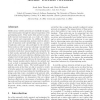Free Online Productivity Tools
i2Speak
i2Symbol
i2OCR
iTex2Img
iWeb2Print
iWeb2Shot
i2Type
iPdf2Split
iPdf2Merge
i2Bopomofo
i2Arabic
i2Style
i2Image
i2PDF
iLatex2Rtf
Sci2ools
IJNSEC
2006
2006
Detecting and Evading Wormholes in Mobile Ad-hoc Wireless Networks
Mobile ad-hoc wireless networks are established in improvised environments through the mutual cooperation of its participating nodes. These nodes often operate in a physically insecure environment and, as a result, are vulnerable to capture and compromise. In addition, the nature of the wireless communication medium restricts enforcement of rigourous node memberships and so a number of malicious nodes may also participate in the network. These nodes, in order to snoop or sabotage, can undertake a variety of attacks against the network. Among these, wormhole attacks have unusual significance primarily due to their modus operandi and peculiar attack pattern. In such attacks, two or more malicious colluding nodes create a higher level virtual tunnel in the network, which is employed to transport packets between the tunnel endpoints. These tunnels emulate shorter links in the network and so act as bait to unsuspecting network nodes which, by default, seek shorter routes. The benefit gaine...
| Added | 12 Dec 2010 |
| Updated | 12 Dec 2010 |
| Type | Journal |
| Year | 2006 |
| Where | IJNSEC |
| Authors | Asad Amir Pirzada, Chris McDonald |
Comments (0)

